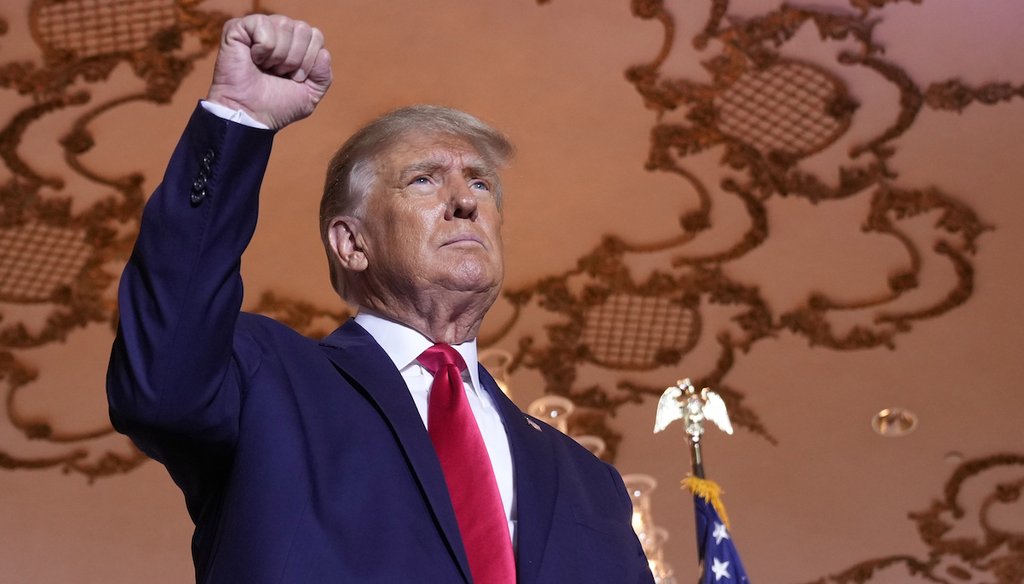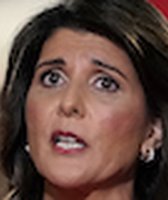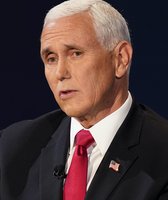Stand up for the facts!
Our only agenda is to publish the truth so you can be an informed participant in democracy.
We need your help.
I would like to contribute

Former President Donald Trump stands onstage Nov. 15, 2022, after announcing a third run for president at his Mar-a-Lago estate in Palm Beach, Fla. (AP)
As he announced another run for the White House, former President Donald Trump promised a "golden age" for Americans while exaggerating his record in office. He glossed over key facts as he spoke about his coronavirus response, the economy, border security and more.
"Together, we built the greatest economy in the history of the world," Trump said in his Nov. 15 speech at his Mar-a-Lago club in Palm Beach, Florida.
Trump claimed that despite his accomplishments, President Joe Biden and the "radical left" drove the country "into the ground." All Biden had to do "was just sit back and watch," Trump said.
Trump resisted his baseless claims about a stolen 2020 election in this speech. He also made significant offhand remarks, suggesting that a missile that exploded in Poland, a NATO ally, and killed two people was "sent in probably by Russia," contrary to early comments from world leaders. Poland President Andrzej Duda said the missile may have been launched by Ukraine as air defense, and Biden said it’s unlikely that the missile came from Russia, but "we’ll see."
Given Trump’s focus on his record, we fact-checked whether various points in the U.S. economy, border security and coronavirus response were as rosy as he said.
Sign up for PolitiFact texts
Trump is painting a more flattering portrait of his initial response to COVID-19. In the early months of 2020, Trump minimized the threat of the virus. He said during a Feb. 10 rally in New Hampshire that COVID-19 may "miraculously" disappear, even though intelligence officials were telling him a different story.
He later snubbed calls to impose a nationwide stay-at-home order, questioned the use of face masks to curb the virus' spread and hyped unproven and potentially dangerous medications on the market as cures. By Nov. 30, 2020, more than 200,000 Americans had died from COVID-19.
Still, Trump signed legislation to provide financial relief to businesses and people impacted by the pandemic — and he oversaw the development of COVID-19 vaccines.
This needs context.
The pandemic-related recession on Trump’s watch was the shortest on record at only two months, according to a National Bureau of Economic Research committee.
However, most past recessions involved multiple financial and economic weaknesses and developed over time. The cause of this recession — a global health challenge whose scope was initially unknown — is unprecedented and not really comparable to past recessions in its duration.
This needs context.
Inflation was lower under Trump than it has been under Biden. Until the pandemic hit, inflation hovered around 2%, just as it had for much of President Barack Obama’s presidency. In recent years, the Federal Reserve, the chief federal entity charged with keeping prices stable, has considered 2% its target for inflation. So that goal was largely met under Trump.
However, inflation never went to "zero" during his presidency. It came close to that in April and May of 2020, but that was when the economy was in a free-fall at the start of the pandemic. Much economic activity stopped amid the initial pandemic shutdowns, and demand for goods and services cratered. So claiming credit for inflation of 1% or less glosses over the fact that the rate was that low not because of economic strength, but rather widespread economic distress.
Under Biden, the inflation rate has been at 40-year highs. Economists say that Biden’s American Rescue Plan, the coronavirus and economic relief bill passed early in his tenure, may have exacerbated inflation but did not create it.
The Energy Information Administration’s data show the national average price of a gallon of gasoline for the week of Jan. 18, 2021, right before Biden’s inauguration, was $2.38, or about 28% higher than what Trump said it was.
Meanwhile, the national average price of gasoline under Biden is $3.76, as of Nov. 14.
We rated a similar claim False. Trump neither "filled up" the Strategic Petroleum Reserve, nor did the stockpile reach full capacity while he was president.
Under Obama, the stockpile reached its highest ever inventory of oil. Between 2016 and 2020, the reserves fell from 695 million barrels to 638 million barrels — a decline of 8.9%.
Trump's suggestion that Biden "virtually drained" the Strategic Petroleum Reserve is also misleading. The latest data as of August from the U.S. Emergency Information Administration showed the reserves had an inventory of 445 million barrels of oil — the lowest since 1984. That is a 30% decrease from when Biden entered office in January 2021.
In October, Biden authorized the release of 15 million barrels of crude oil from the Strategic Petroleum Reserve, completing a plan to release 180 million barrels this year. The White House said the withdrawal was designed to stabilize crude oil markets and reduce gasoline prices.
This is inaccurate.
There were at least seven attacks in the U.S. between 2017 and 2019 whose assailants cited an allegiance to the Islamic State, al-Qaida or their Islamic faith as inspiration for the attack. That’s according to Reveal, an investigative news outlet and New America, a think tank tracking how many people have been killed in terrorist attacks in the United States since 9/11.
The deadliest of these attacks happened on Nov. 2, 2017, when Sayfullo Habibullaevic Saipov drove a truck into people on a New York City bike path. Eight people were killed and at least 12 others were injured. Authorities charged Saipov with counts of murder, attempted murder, and attempting to provide material support to the Islamic State of Iraq and ISIS.
At the time, Trump posted a series of tweets saying he wished Saipov could be shipped to Guantanamo Bay and that he should get the death penalty, The Washington Post reported.
Trump also omits the threat of domestic terrorism, which federal law enforcement authorities say is on the rise. Between 2017 and 2019, Reveal recorded 30 right-wing terrorist attacks, including the 2018 mass shooting at the Tree of Life Synagogue in Pittsburgh, Pa., that killed 11, and the 2019 mass shooting targeting Latinos at a Walmart in El Paso, Texas that killed 22.
This isn’t accurate.
Trump broke his promise to "build a great wall," on the southern border and "have Mexico pay for that wall," PolitiFact found.
Trump mainly replaced barriers that had been installed by past administrations. Before Trump’s presidency, the southwest border had 645 miles of barriers, that increased by three miles under Trump. U.S. taxpayers, not Mexico, paid for these projects.
That’s a significant overstatement. Trump invested in the military's operational readiness, but those investments were far from a complete overhaul.
Total defense budgets during Trump's term exceeded $2 trillion, but not all of that funding went toward buying and upgrading equipment and infrastructure.
Trump's claim that he went "decades without a war" is confounding. He served only four years as president, and during that time, the U.S. was involved in several wars, including Afghanistan, Iraq and Syria.
Trump did not seek authorization from Congress for use of military force, or a formal declaration of war against any other country. But Trump did order and oversee new military operations under existing wars.
He presided over 951 aerial attacks across Afghanistan, Iraq, Syria, Somalia and Yemen in 2020, according to a report from AirWars, an airstrike monitoring group.
Our Sources
See links in story.















































